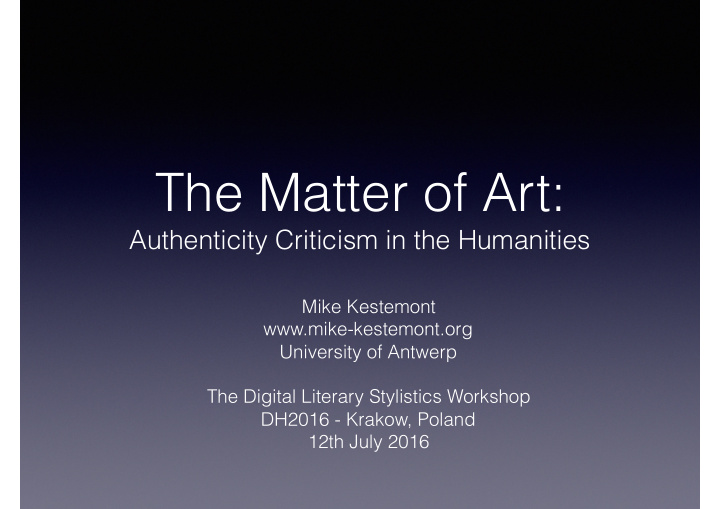



The Matter of Art: Authenticity Criticism in the Humanities Mike Kestemont www.mike-kestemont.org University of Antwerp The Digital Literary Stylistics Workshop DH2016 - Krakow, Poland 12th July 2016
Authentication Stylistics ~ authentication • authentic vs (fake vs misattributed) • Problem across the Humanities • learn from / teach other fields • Focus: • Art History (pictorial, visual arts) • “Authorship” authentication •
Difference Hard to compare because of “materiality”: • a late copy of Shakespeare can still be “real” • a copy of a Picasso, however perfect, cannot • Art historians always work with “autographs” • Prime importance of the original “carrier” • Emphasis on materiality • Physical, Chemical analysis (e.g. ink, • cloth, …) cf. Pollock’s polar bear •
Connoisseurship • Authentication still primarily expert-driven • art-market professionals: dealers, curators, art historians, … • All the problems that “we” react to, knowledge: • dies with the experts • is to implicit to be shared • is barely replicable (cf. inter-subjectivity) • Huge economic potential • Much more explicit legal system than for textual authorship • Experts do not give up control?
“Stylistic” analysis • Morphological, visual inspection • Pioneered by Giovanni Morelli (late 19C) • Grundformen • Ears and hands >< “content” • Surprisingly similar to ‘function words’ • Interesting to trace in other fields • E.g. Minio-Paluello, “particle method” • Hardly any quantification…
Huge potential • Computational, digital studies (surprisingly) scarce, despite expert dominance • Authentication-in-Art conference • Apart from scattered small-scale studies, mainly canon (e.g. Van Gogh) • Despite huge potential • Number of extremely valuable studies using Machine Learning
Rijksmuseum dataset PigeoNET • Huge advances in Computer • Vision Promising attribution results using • data-driven method Even differentiate collaborating • painters within painting “Rolling Stylometry” in 2D! •
Neural Style Transfer Superimpose style of painting onto another (‘AI Photoshop filter’)
Conclusions • As we inaugurate this SIG, good to keep looking across the borders: • Authentication: generic problem, societal & economic relevance • Learn from each other’s vocabulary • Learn to define and explain/visualize styles • Art history: • Interesting parallels (that call for modesty) • Computer less ‘institutionalized’? (pad ourselves on the chest?) • Neural Style Transfer for literary authors?
Selected references • Van Noord et al. Toward Discovery of the Artist's Style: Learning to recognize artists by their artworks. IEEE Signal Process. Mag. 2015. • Gatys et al., A Neural Algorithm of Artistic Style, ArXiv 2015. • McClean, D., Authenticity in Art and Law. A Question of Attribution or Authorization? Art.zip . • Melius, J. Connoisseurship, Painting, and Personhood. Art History 2011. • Watanabe, S. et al.“Pigeons’ discrimination of paint- ings by Monet and Picasso,” J. Exp. Anal. Behav. 1995. • Kestemont, M.. “Function Words in Authorship Attribution. From Black Magic to Theory?” Proceedings of CLfL 2016.
Recommend
More recommend